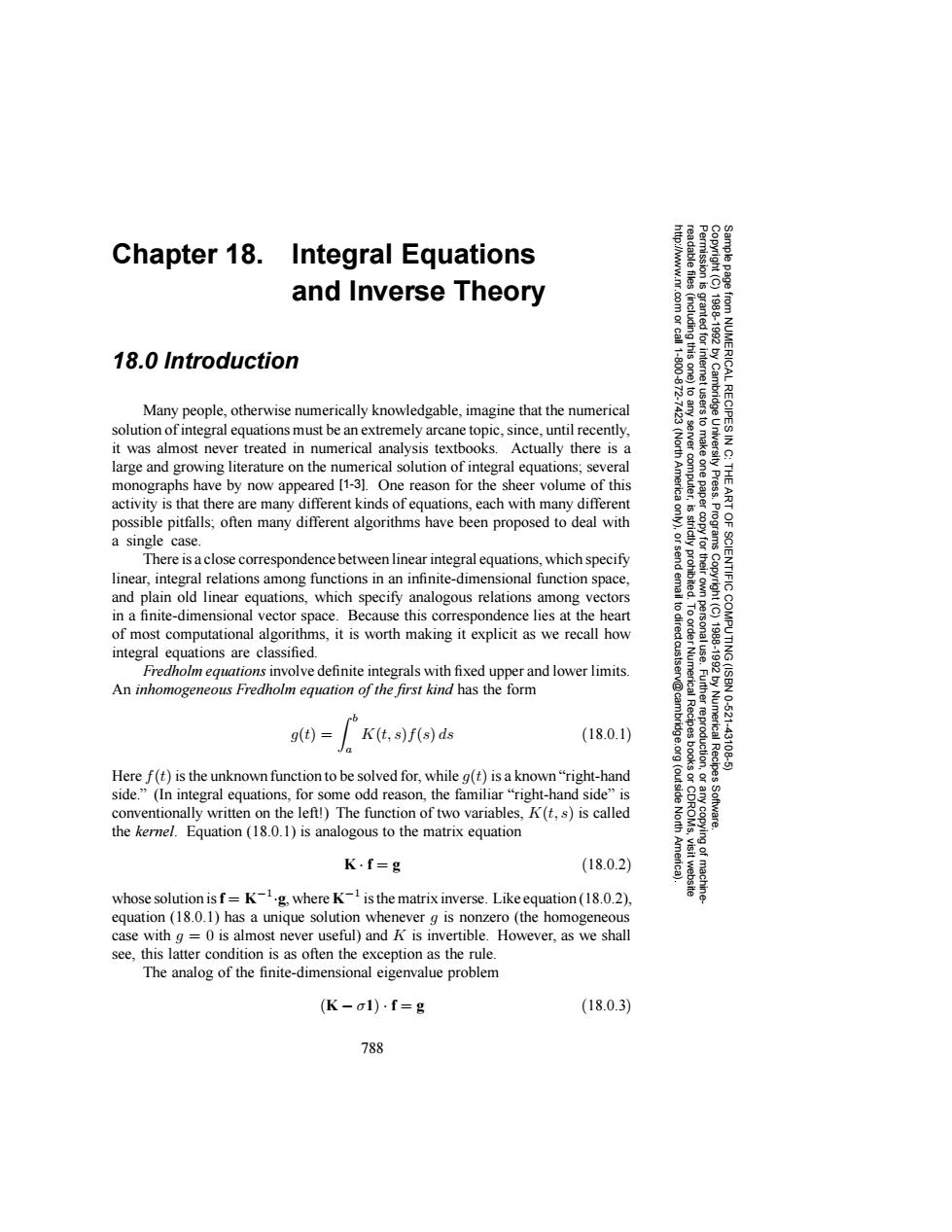正在加载图片...

Chapter 18.Integral Equations http://www.nr. and Inverse Theory .com 18.0 Introduction A6o会 NUMERICAL Cambridge Many people,otherwise numerically knowledgable,imagine that the numerical solution of integral equations must be an extremely arcane topic,since,until recently. RECIPES IN it was almost never treated in numerical analysis textbooks.Actually there is a large and growing literature on the numerical solution of integral equations;several monographs have by now appeared [1-31.One reason for the sheer volume of this Press C:THEA activity is that there are many different kinds of equations,each with many different possible pitfalls;often many different algorithms have been proposed to deal with a single case 9 是 There is a close correspondence between linear integral equations,which specify linear,integral relations among functions in an infinite-dimensional function space, SCIENTIFIC and plain old linear equations,which specify analogous relations among vectors in a finite-dimensional vector space.Because this correspondence lies at the heart of most computational algorithms,it is worth making it explicit as we recall how 量 integral equations are classified. Fredholm equations involve definite integrals with fixed upper and lower limits. 92y An inhomogeneous Fredholm equation of the first kind has the form g(t)= K(t,s)f(s)ds (18.0.1) Recipes Here f(t)is the unknown function to be solved for,while g(t)is a known"right-hand side."(In integral equations,for some odd reason,the familiar"right-hand side"is (outside ecipes conventionally written on the left!)The function of two variables,K(t,s)is called Software. the kernel.Equation(18.0.1)is analogous to the matrix equation K.f=g (18.0.2) America visit website whose solution isf=K-1.g,where K-is the matrix inverse.Like equation(18.0.2), machine- equation (18.0.1)has a unique solution whenever g is nonzero(the homogeneous case with g=0 is almost never useful)and K is invertible.However,as we shall see,this latter condition is as often the exception as the rule. The analog of the finite-dimensional eigenvalue problem (K-σ1)·f=g (18.0.3) 788Permission is granted for internet users to make one paper copy for their own personal use. Further reproduction, or any copyin Copyright (C) 1988-1992 by Cambridge University Press. Programs Copyright (C) 1988-1992 by Numerical Recipes Software. Sample page from NUMERICAL RECIPES IN C: THE ART OF SCIENTIFIC COMPUTING (ISBN 0-521-43108-5) g of machinereadable files (including this one) to any server computer, is strictly prohibited. To order Numerical Recipes books or CDROMs, visit website http://www.nr.com or call 1-800-872-7423 (North America only), or send email to directcustserv@cambridge.org (outside North America). Chapter 18. Integral Equations and Inverse Theory 18.0 Introduction Many people, otherwise numerically knowledgable, imagine that the numerical solution of integral equations must be an extremely arcane topic, since, until recently, it was almost never treated in numerical analysis textbooks. Actually there is a large and growing literature on the numerical solution of integral equations; several monographs have by now appeared [1-3]. One reason for the sheer volume of this activity is that there are many different kinds of equations, each with many different possible pitfalls; often many different algorithms have been proposed to deal with a single case. There is a close correspondencebetween linear integral equations, which specify linear, integral relations among functions in an infinite-dimensional function space, and plain old linear equations, which specify analogous relations among vectors in a finite-dimensional vector space. Because this correspondence lies at the heart of most computational algorithms, it is worth making it explicit as we recall how integral equations are classified. Fredholm equations involve definite integrals with fixed upper and lower limits. An inhomogeneous Fredholm equation of the first kind has the form g(t) = b a K(t, s)f(s) ds (18.0.1) Here f(t) is the unknown function to be solved for, while g(t) is a known “right-hand side.” (In integral equations, for some odd reason, the familiar “right-hand side” is conventionally written on the left!) The function of two variables, K(t, s) is called the kernel. Equation (18.0.1) is analogous to the matrix equation K · f = g (18.0.2) whose solution isf = K−1·g, where K−1 is the matrix inverse. Like equation (18.0.2), equation (18.0.1) has a unique solution whenever g is nonzero (the homogeneous case with g = 0 is almost never useful) and K is invertible. However, as we shall see, this latter condition is as often the exception as the rule. The analog of the finite-dimensional eigenvalue problem (K − σ1) · f = g (18.0.3) 788